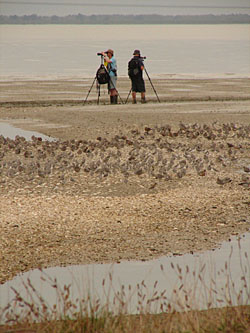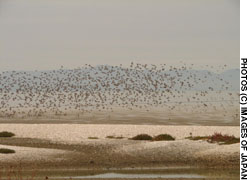Mud, mud, glorious mud
By Mark Brazil | May 17, 2006
WETLANDS WIPEOUTLoss: That sense of deep detachment when a loved one has departed; the bewilderment and displacement at finding something or somewhere treasured to have gone; the confusion of returning to one’s childhood haunts only to find them changed beyond recognition. We have, no doubt, all felt these loses, but what puts them in context?
We can only measure a loss when we know both the before and the after; we have a sense of it when we experience the change itself, but even that process lacks the immense shock value of finding “it” suddenly gone.
Recognizing loss becomes very difficult to register when you have no sense of what was present in the past.
It’s unlikely you will feel too melancholic about never having seen a horde of geese — or even a single snow goose — in the Tokyo area. Today the snow goose’s only Asian breeding ground is on the remote Russian Wrangell Island, from which they migrate to winter in North America, not Asia. Yet back in 1860, enormous flocks of these very geese were described by naturalists of that era as being “like snow” around Tokyo Bay. So, once there were thousands, possibly even tens of thousands; now, all are gone.
Where did they breed? Some remote region of Siberian tundra in Chukotka or Yakutia must once have been filled with the clamor of their arrival in spring — perhaps even a silent tundra region I have walked across. Yet that tundra seems filled with life today to one unknowing of the past.
Similarly, I have visited places in South America, India, Africa and Indonesia and been impressed with the diversity of mammal and bird life there — only to be astonished, when hearing from old hands, how much more there was to see a mere 50 years ago.
It’s so hard to imagine what was there a century ago and more — the context of time, the personal experience of “before and after,” is simply missing. Future reflectors on the past will have film, video and digital images with which to recognize change; we, for the most part, must use our imaginations.
By all accounts, in the late 1800s the immense tidal flats of Tokyo Bay teemed with animal life, not least with enormous migratory flocks of shorebirds that stopped off on their seasonal journeys. Today, the birds are gone, along with the mudflats — habitat not only for birds, but for invertebrates and fish.
What happened to those innumerable displaced birds? Some no doubt were lucky and found other sites to stop at, before steadily, decade by decade, those coastal wetland sites have been embanked and drained — reclaimed from the sea for one reason or another, often merely to support the construction industry.
Tide and moon
In the 1980s and early ’90s, I used to often visit a superb wetland called Isahaya Bay in Kyushu, where shorebirds galore, including rarities and endangered species, passed through. I dare not return now. When I last saw it, an embankment was snaking its way out across the bay in readiness for closing it off from the sea, and breaking the link with tide and moon, with cockles and razorshells — and migratory birds.
The loss of wetlands along the migratory route known as the East Asian Flyway has relentlessly impacted migratory birds not only locally, but also at both ends of the flyway in Russia and in Southeast Asia and Australasia.
Each time I return to the open, undulating tundra, with its myriad pools and swarming insect life, or each time I visit taiga forest marshes and wetlands, I wonder what used to breed there, what calls used to echo in those now largely empty places. Watching bar-tailed godwits and other shorebirds in New Zealand recently (as I described in my April 19 column), I was impressed by their numbers. But again I heard locally that they were a mere fraction of those even just a decade or so ago.
A colleague studying a shorebird on the American Flyway named the red knot has been untangling that species’ knotted natural history, and following its dramatic decline. The problem, as in Asia, is not with the Arctic breeding grounds, nor the southern hemisphere wintering grounds — it is with the once-abundant stopover sites in between.
Imagine driving onto a long-distance highway with your tank full of fuel, then learning that half or more of the gasoline stands along the way have been closed and more are closing all the time. Which will be open, which closed? Do you break your journey at every one that’s open, join the line and hope to top up your tank before supplies run out? Or do you press on, praying that you make it to journey’s end, or to a far-distant stand (if it still exists) that may have supplies and a short line?
Migratory shorebirds face these same problems, compounded with the urge to arrive quickly at those distant Arctic breeding grounds to fend off competitors for a territory and a mate before settling down to breed. For all of this, energy from healthy fat supplies is essential. Come autumn, the shorebirds and their less-experienced young must run the same gauntlet southwards.
It’s not a promising thought. Nor have the closures ended.
We are seeing the tail end of a nationwide and flyway-wide decline in shorebird numbers. I say the tail end, because judging by accounts from the late 19th century, losses then were already immense, and over the intervening century the continuing steady reclamation of the last remaining wetlands that the shorebirds require for feeding has been wiping out the remaining birds.
Although city mayors, developers and construction companies have at various times stated their assumption that the birds can move elsewhere, they have failed to comprehend the depth of the situation. Of course, birds can fly, they can move elsewhere. But to feed, especially when on migration and when they need to restore depleted energy, they need particular types of food found in particular habitats. As wetlands have been reclaimed, there have been fewer and fewer places for them to move to, and those wetlands have a limited carrying capacity.
The dramatic decline in shorebirds is itself very sad, but it reveals the loss of many other less conspicuous species, and even whole habitats too.
Over recent decades Japan has averaged annual losses exceeding 1 percent of its tidal flats, and the losses continue.
Meanwhile, Japan’s increasingly wealthy neighbors, South Korea and China, have also been making inroads into their coastal wetlands. Recent experiences with tsunami in South and Southeast Asia, and hurricanes in North America, have shown just how vital “soft-engineered” coastlines with natural mangroves and mudflats and so on are for buffering wave surges, absorbing floodwaters and protecting not only natural life, but also human life. However, it seems that the countries of East Asia are hell-bent on ignoring that experience.
Massive reclamation
Losses in the past are hard to grasp, but you can see what is involved if you track the progress of massive reclamation projects in countries such as South Korea. There at Saemangeum, 40,100 hectares of tidal flats and shallows are currently being closed off from the sea. And the biggest irony: Only after the reclamation will discussion take place on how best to use the new land. All this at a place identified in a key 2002 study as the single most important known site for shorebirds in the Yellow Sea (the report is available online at: www.deh.gov.au/biodiversity/migratory/waterbirds/yellow-sea/index.html).
While the impact on migratory shorebirds from this project are expected to be enormous and long term, monitoring is being undertaken — so at least the losses will be known, including the effects on some of Asia’s rarest and most charismatic birds, such as the spoon-billed sandpiper, Nordmann’s greenshank, great knot and Saunders’s gull.
If you are interested in the issue, then I recommend you follow the progress of reclamation, the fight against it and the fate of the birds, by logging on to sites such as those of the Australasian Wader Studies Group and particularly Birds Korea, who are monitoring the situation and providing information (see: www.birdskorea.org/saemref.asp).
A further irony in this case is that — while setting one of the worst examples of profligately wasting the wetlands it was once so rich in — South Korea is set to host the 2008 Ramsar Convention on wise use of wetlands.
Alarmingly, forecast models have indicated that this single massive reclamation project will lead to a 30-cm rise in sea level in much of the Yellow Sea, further reducing wetlands elsewhere and rendering yet more of the coast vulnerable to tidal surges, storms and tidal waves.
Meanwhile, as one project nears completion another is slated — this time on the neighboring Geum estuary — showing further disregard for the area’s international importance to migratory shorebirds and coastal security. Where will it all end?


